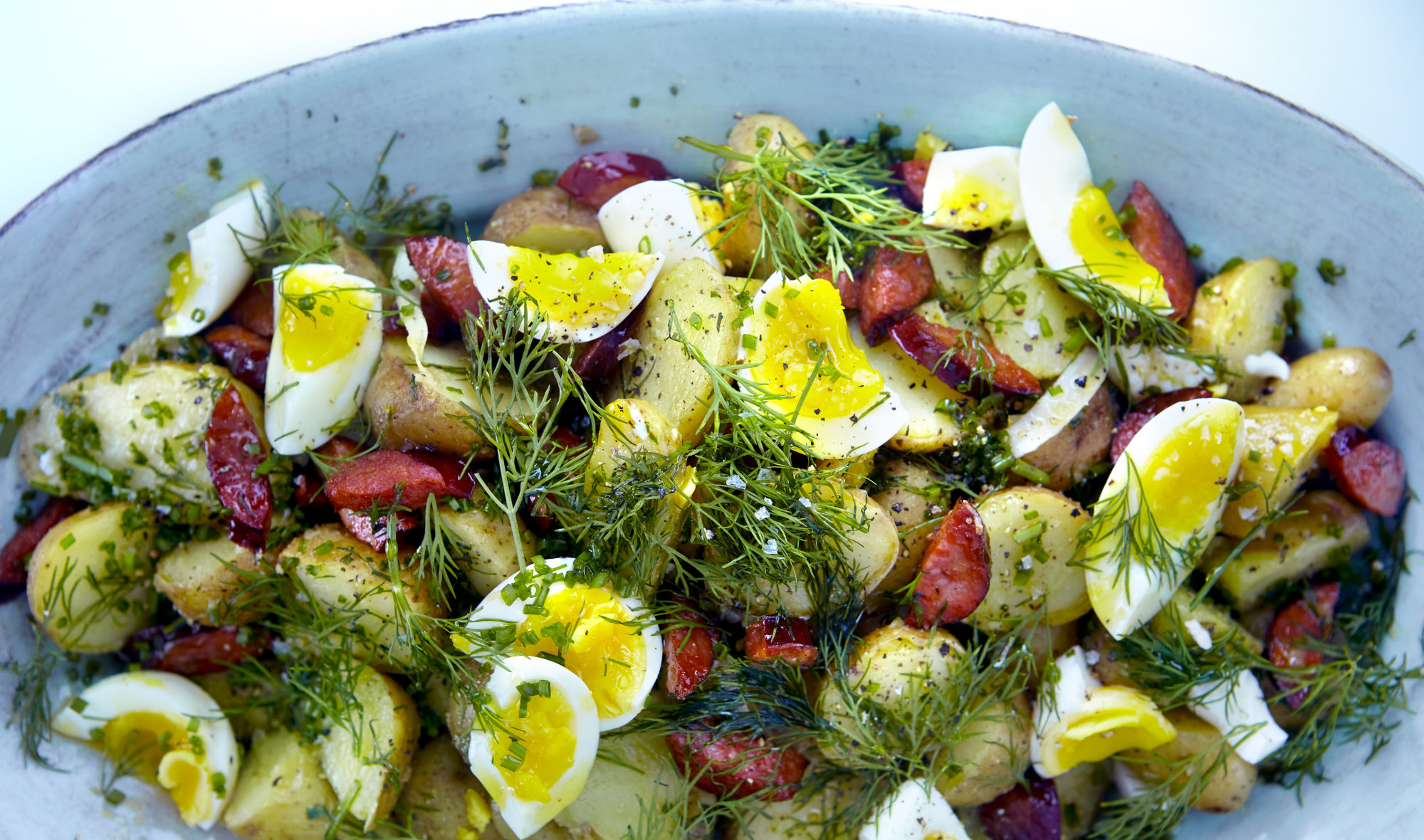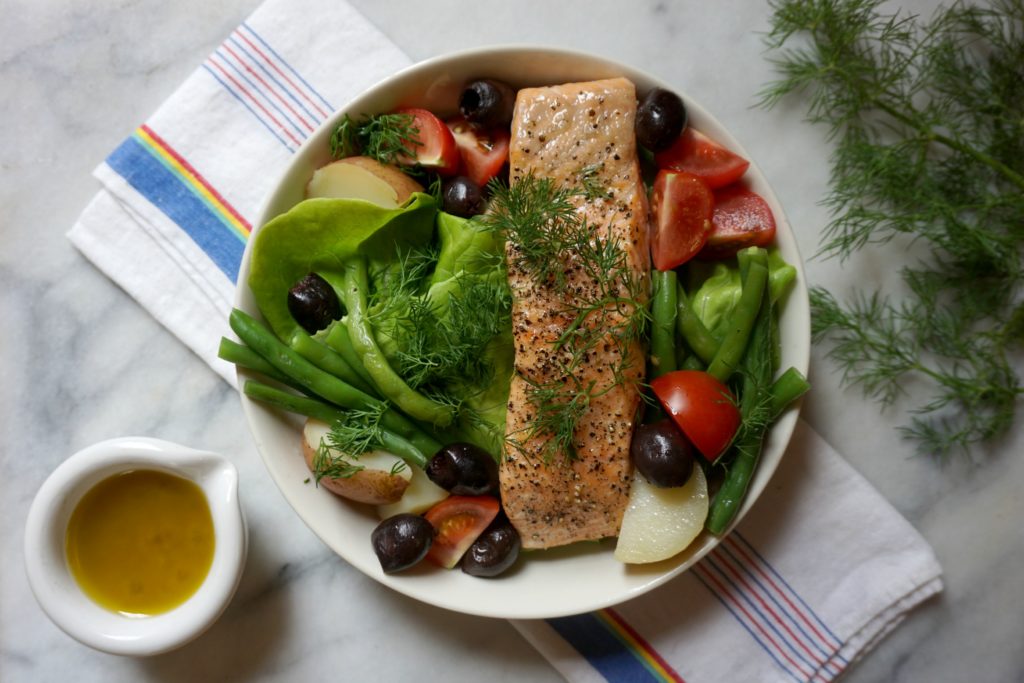
🎁 Holiday Special: SAVE 52% on the Nutrition Coach Starter Package. Limited number remaining.

🎁 Holiday Special: SAVE 52% on the Nutrition Coach Starter Package. Limited # left.

Dill weed is a fun-looking plant with feathery, thread-like green leaves that branch out in all directions. Fresh dill has a strong grassy flavor with notes of anise and parsley. If left to mature, the plant will sprout an umbrella of tiny yellow flowers that will eventually turn to seed. The seed is also used culinarily and has a very potent aromatic flavor, similar to caraway seeds. Like many aromatic plants, dill is used in traditional medicine to ease indigestion. Although dill is rarely consumed in large amounts, it is proportionately rich in vitamin C, manganese, iron, and folate. Dill is delicious in a variety of recipes and is a key ingredient in many Eastern European dishes. However, dill is perhaps most famous for its supporting role in the creation of pickles.
Dill is a culinary herb with wispy, thread-like leaves that branch out in all directions. It is in the Apiaceae family, which also includes celery, carrots, and parsley.
Dill is native to Eastern Europe and is a common ingredient in many traditional dishes from these regions. Dill appears in many Eastern European dishes, for example, the iconic cold beet soup, borscht. In North America, dill is often associated with pickles, as it is a traditional component of the aromatic brine that turns cucumbers into pickles. It also pairs well with fish and mild, creamy cheeses.
Dill grows in temperate climates and loves the sun. If left to mature, the dill plant will sprout small yellow flowers that will eventually turn to seed. These seeds are also used as a culinary spice and have a very potent aromatic flavor similar to caraway seeds.
In traditional medicine, both dill weed and dill seed are used to treat indigestion.
Dill weed is a fun-looking plant with feathery, thread-like green leaves that branch out in all directions. If left to mature, the plant will sprout an umbrella of tiny yellow flowers that will eventually turn to seed.
Fresh dill is highly aromatic and has a strong grassy flavor with notes of anise and parsley.
Dill weed can also be found as a dried herb. Dried dill looks like a bunch of green splinters, and has a slightly more mellow, earthy flavor compared to its fresh counterpart.
Dill seed is also used culinarily and has a very potent aromatic flavor, similar to caraway seeds.
One cup of fresh dill weed (about 9g) has 4 calories, 0.3g protein, 0.1g of fat, 0.6g of carbohydrates, 0.2g fiber, and no sugar. Although dill is rarely consumed in large amounts, it is proportionately rich in vitamin C, manganese, iron, and folate (vitamin B9).
Fresh dill is widely available and can be found at most large grocery stores and fruit and vegetable markets.
When selecting dill, try to find the fresh herb over the dried herb, as it is more fragrant and delicious.
Look for bunches that are green and feathery with fairly upright stems. Dill wilts quickly after harvesting, so a little drooping is ok. Avoid bunches that look brown, slimy, or exceptionally floppy.
If choosing dried dill, shop at stores with high product turnover. Dried dill loses aroma and potency quickly. For this reason, see if you can smell the dried dill before you purchase it. Good quality dried dill will still smell potent and aromatic. Avoid dill that has little smell or a dusty color, as it is probably past its prime.
Dill seeds have a longer shelf like but the same rules still apply. In short, if it smells fragrant and looks good, it probably is good.
Fresh dill is fairly delicate and may only last two to three days in the fridge. The best way to store it is to place it stems down into a glass of water and cover its leaves with a plastic bag. This will ensure that the leaves stay relatively turgid and protected from damage from the cold.
Like all dried herbs and spices, dried dill weed or seeds should be stored in an airtight container in a cool, dry, and dark environment. Stored like this, they will last three to four months.
Although fresh dill is rarely eaten solo, technically it doesn’t need any special preparation (other than a quick rinse) to be eaten.
However, fresh dill really shines when chopped finely and added to salads, cooked vegetables, sandwiches, pasta, and fish. It pairs particularly well with salmon and soft, mild cheeses.

Although a classic Nicoise salad is made with tuna, we think it’s nice with perfectly cooked salmon, which is a perfect match with fresh aromatic dill. Nicoise salad has all the light and vibrant flavors of a salad, with a satisfying heartiness too.
Prep Time: 10 minutes Cook Time: 10 minutes Yield: 2 servings
First, cook your salmon filets: Preheat the oven to 400 degrees Fahrenheit and line a pan with parchment paper. Drizzle the salmon filets with olive oil, and season with salt and pepper. Place filets skin-side-down on to the parchment and place the pan in the oven. Salmon takes about 4-6 minutes per half inch of thickness to cook. Most filets are about an inch thick at the thickest part, so begin checking the salmon at about 8 minutes in. Salmon is cooked when the flesh has turned opaque and flakes easily with a fork.
While the salmon is cooking, make the dressing: In a jar, add olive oil, lemon juice, mustard, garlic, honey, and salt, and whisk together until combined. Set aside.
Divide lettuce, cooked potatoes, cooked green beans, tomatoes, and olives between two shallow bowls. Place salmon over salads, sprinkle with dill and drizzle with dressing. Serve immediately.
Precision Nutrition’s Encyclopedia of Food expands every single month as we highlight new foods and showcase beautiful food photography. If you’d like to stay up to date, simply click this link. From there, we’ll send you a FREE copy of our recipe book. We’ll also let you know when new and delicious foods are added to the site.
Dill weed is a fun-looking plant with feathery, thread-like green leaves that branch out in all directions. Fresh dill has a strong grassy flavor with notes of anise and parsley. If left to mature, the plant will sprout an umbrella of tiny yellow flowers that will eventually turn to seed. The seed is also used culinarily and has a very potent aromatic flavor, similar to caraway seeds. Like many aromatic plants, dill is used in traditional medicine to ease indigestion. Although dill is rarely consumed in large amounts, it is proportionately rich in vitamin C, manganese, iron, and folate. Dill is delicious in a variety of recipes and is a key ingredient in many Eastern European dishes. However, dill is perhaps most famous for its supporting role in the creation of pickles.